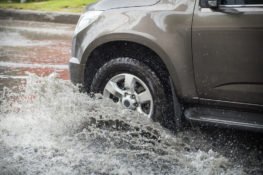
Driving on the nation’s roads and highways is an inherently risky proposition even in the best of conditions. There are times, however, when being behind the wheel can be even more dangerous than usual. One of the most dangerous of those times occurs during periods of inclement weather, when a variety of elemental factors can combine to increase the risk that your vehicle could be involved in a crash or other accident. Wet roads are of particular concern, and can diminish your ability to maintain control on the road as they increase the danger that you might experience hydroplaning.
What is Hydroplaning?
Hydroplaning is an often-misunderstood phenomenon where the water on the road surface in front of your vehicle gathers together more rapidly than your tires are able to push it away. When that happens, the pressure of all that water is enough to elevate your car so that it slides on a thin layer of liquid, breaking the tires’ direct contact with the road surface. At that point, you can lose all traction in a fraction of a second and find yourself careening out of control.
It is important to remember, of course, that this phenomenon can occur even without a large amount of accumulated rainfall, and even at lower speeds. In fact, the greatest potential for hydroplaning can occur within the first ten minutes or even a light rain as that water can combine with the oil residue that automobiles leave on the surface of the road. That combination of water and oil creates the ideal conditions for slippery roads, and thus increases the potential for loss of control.
How Prevalent is the Problem?
Automobile crashes are a veritable epidemic in the United States. More than 37,000 people die in crashes each year, with more than 2.3 million other victims suffering injury or permanent disability. Worse, there are more than 5.7 million vehicular crashes on the nation’s roads and highways each year, and official estimates suggest that about 22% of those accidents are related to weather. Estimates also indicate that as many as one out of every four traffic accident deaths and 445,000 injuries each year are the result of crashes in some type of inclement weather.
Of those deaths and injuries related to weather, 46% occurred during rainfall, and fully 73% occurred on wet roads. When you contrast those statistics with the 27% of accidents that occurred during snowy and icy road conditions, it is even clearer that wet road conditions are perhaps the single greatest weather-related accident risk factor today’s drivers face. It’s no wonder that the National Institute of Health concluded that the nation’s driver training programs should be revised to focus more on the specific dangers associated with wet and slippery road surfaces.
What Causes Hydroplaning?
It is important to understand that there are more factors involved in a hydroplaning incident than just the random interaction of water and tires. There are a variety of road factors that can contribute to the underlying conditions, including wheel track depth, road grade, and pavement texture. Environmental factors like rainfall duration and intensity, as well as water depth, can also play a role. Finally, driver and vehicle factors are critically important. The vehicle’s speed, braking, steering, tread wear, and tire inflation are critically important to determining the amount of risk that you face.
Preventing Hydroplaning
Given the danger associated with this phenomenon, it is important for every driver to know how to protect himself and limit his risk as much as possible. The best prevention begins before you ever get out on the road and starts with proper vehicle maintenance. Proper tire inflation is a must since low pressure can make your tires especially vulnerable to hydroplaning. Make sure that your brakes are in working order as well, so that you know that you can rely on them in inclement weather.
It is also important to understand that you need to check your brakes while driving, especially when rainfall begins. Water can reduce the efficiency of your brakes, so you should be prepared to drag them for a short distance in rainy conditions. That will help to dry them out and improve their effectiveness.
Other preventive measures include common-sense measures like slowing down when conditions are wet. That water on the road can result in your vehicle needing twice as much distance as usual when you are trying to stop. Also, when you have to slow down, do so gradually to avoid the type of aggressive braking that could result in a loss of control.
To avoid potential collisions with other vehicles that may suffer hydroplaning, increase the distance between your car and others on the road. Make sure that your lights are on, even during the day, to ensure that you are visible to everyone else on the road. Be cognizant of the fact that other vehicles can cause water to fly onto your windows, impairing your visibility.
What to Do When Hydroplaning Occurs
Despite your best efforts to prevent it, there may be times when your vehicle suffers from this phenomenon. If that happens, it is vital that you know how to react:
- Do not slam on your brakes. In fact, do not use your brakes at all, as that may cause a sudden loss of control.
- Instead of the brakes, simply release the accelerator to allow the vehicle to gradually lose speed on its own.
- Make small steering corrections if you are drifting, but do everything you can to just keep going straight forward. Sharper steering wheel movements can cause your vehicle to swerve into another lane. Remember, you’re gliding over water, so your control is limited at best.
- As your vehicle starts to slow, you should regain some contact with the road. At that point, you can safely ease onto the brakes.
How you choose to react may be somewhat different based on the exact road conditions, the movement of your vehicle, and how close other vehicles are to you on the road. However, if you recognize the danger and adhere to these basic safety and prevention tips, you can increase the odds of avoiding a dangerous hydroplaning crash.








